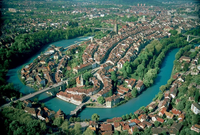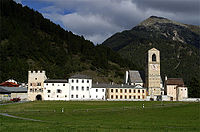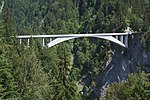World heritage in Switzerland
Swiss World Heritage Sites (without the 56 sites of prehistoric pile dwellings, blue = part of a World Heritage site) |
The World Heritage in Switzerland ( French patrimoine mondial en Suisse , Italian patrimonio mondiale in Svizzera , Rhaeto-Romanic patrimoni mundial en Svizra ) comprises (as of 2017) twelve UNESCO World Heritage sites , including nine World Heritage Sites and three World Natural Heritage sites. Four of these sites are cross-border or transnational .
The Switzerland had in 1975 signed the World Heritage Convention. In 1983, the first three Swiss World Heritage sites were awarded with the Old Town of Bern , the St. Johann Benedictine Monastery and the Prince Abbey of St. Gallen . It was not until the late 1990s that the Federal Council submitted new nominations to the selection committee . In 2001, with the Swiss Alps Jungfrau-Aletsch region , a Swiss World Heritage Site was added to the UNESCO list for the first time; the last World Heritage Site to date was entered in 2016.
history
In November 1972, the General Conference of UNESCO in Paris passed the Convention for the Protection of the World’s Cultural and Natural Assets (World Heritage Convention ). The aim of the convention is to protect cultural and natural goods that have an “exceptional universal value” and to preserve them as part of the world heritage of all humanity. In June 1975 the Swiss Federal Assembly authorized the Federal Council to ratify the Convention . The World Heritage Convention finally came into force for Switzerland on December 17, 1975.
In 1983 three Swiss cultural assets were added to the World Heritage List. With the Zähringer city of Bern , the Carolingian monastery of St. Johann in Müstair and the baroque prince abbey of St. Gallen, different types of construction and uses of sacred and secular buildings were taken into account. The Swiss Commission for UNESCO believed that it had recorded Switzerland's most important contributions to the world's cultural heritage. In 1999 the Swiss National Committee of ICOMOS confirmed this view and advocated a moratorium on the nomination of further sites.
Regardless of this, the three castles of Bellinzona were recognized as a further cultural asset as UNESCO World Heritage in 2000 . In the years that followed, Switzerland's candidacies focused on natural resources and cultural landscapes . It followed the resolutions of the 12th General Assembly of the States Parties to the World Heritage Convention, according to which a “representative, balanced and credible World Heritage list” should be promoted.
In 2004, the Federal Office for Culture and the Federal Office for the Environment, Forests and Landscape set up a group of experts to draw up a tentative list (list indicative) of possible candidates in accordance with the requirements of the World Heritage Commission . A total of five sites were recommended for candidacy. The recommendations of the commission were implemented by the Federal Council by 2010, the proposals were recognized as World Heritage by 2016. In 2017, Switzerland put two new proposals on the tentative list.
organization
According to the guidelines for the implementation of the Convention for the Protection of the World’s Cultural and Natural Heritage , only the contracting states can submit nominations. At the international level, a nomination is transmitted by the Swiss Federal Council. At the national level, the Federal Office of Culture (BAK) and the Federal Office for the Environment (FOEN) are responsible for the world heritage in Switzerland. The Swiss UNESCO Commission also advises the federal government on its relations with UNESCO.
In principle, individuals, municipalities , cantons or organizations can propose a candidacy for World Heritage status. The legal basis for the recognition of possible World Heritage sites is the Federal Law on Nature and Heritage Protection of 1966. The basis for the protection and maintenance of World Heritage sites in Switzerland is the Federal Law on Spatial Planning of 1979. Both the cantons concerned and the responsible Federal Office must approve the nomination, only then does the Federal Council make a final decision on the candidacy. The Federal Council also arranges for the necessary candidate files to be drawn up at the competent federal office. Since 2004, only proposals that have been placed on the tentative list have been processed. A revision of this list was rejected in 2007 and only took place in 2017 after all previous entries had been included in the World Heritage by 2016.
Each signatory state can register a maximum of two candidacies per year, which the World Heritage Committee decides on at an annual meeting. From 1978 to 1985 Switzerland was a member of the World Heritage Committee. In October 2009, Switzerland was re-elected to the committee for a four-year term.
World heritage sites
The following table lists the UNESCO World Heritage Sites in Switzerland in chronological order according to the year they were added to the World Heritage List. The description of the World Heritage Sites is based on the information in the UNESCO World Heritage List or on the publications of the Swiss UNESCO Commission.
![]() Map with all coordinates of World Heritage Sites: OSM
Map with all coordinates of World Heritage Sites: OSM
| image | designation | year | Type | Ref. | description |
|---|---|---|---|---|---|
|
Old town of Bern ( location ) |
1983 | K | 267 | The historic city center of Bern includes buildings from several centuries, most of which have been preserved in their original substance. Despite the increasingly complex functions that Bern had to fulfill as a federal city , the old town was able to retain its medieval structure. | |
|
St. Gallen Abbey District ( location ) |
1983 | K | 268 | The Benedictine monastery, founded in 719, was an important cultural center of the West as a princely abbey until secularization in 1805 . Abbey library and archive house a valuable collection of early medieval manuscripts and, as mobile cultural assets, complement the baroque ensemble of buildings around the abbey church . | |
|
Benedictine convent St. Johann in Müstair ( Lage ) |
1983 | K | 269 | The monastery, founded around 800, is considered a foundation of Charlemagne . It has been a Benedictine convent since the 12th century . The main attractions are the Carolingian frescoes , rediscovered at the end of the 19th century , which form a cycle of mural paintings. | |
| Three castles of Bellinzona | 2000 | K | 884 | The medieval fortifications of the city of Bellinzona consist of the central castle Castelgrande ( Lage ), the neighboring castles Montebello ( Lage ) and Sasso Corbaro ( Lage ) as well as the connecting fortress walls. | |
|
Swiss Alps Jungfrau-Aletsch ( location ) |
2001 | N | 1037 | The 824 km² extensive area with the mountains Eiger , Mönch and Jungfrau and the Great Aletsch glacier is the largest contiguous glaciated area in Eurasia . The World Heritage comprised first the Jungfrau-Aletsch region Bietschhorn and was expanded in 2007 to its present size. | |
|
Monte San Giorgio ( location ) |
2003 | N | 1090 | The 1097 m high mountain, located between the southern arms of Lake Lugano , is considered the most important site for fossils from the Central Triassic . Scientific excavations since 1924 have uncovered numerous fossils of fish , reptiles , crustaceans and insects .
In 2010 the World Heritage site was expanded to include the southern part belonging to Italy. |
|
|
Lavaux vineyard terraces ( location ) |
2007 | K | 1243 | The steep slopes to Lake Geneva between Lausanne and Vevey were already used by monks in the 11th century to cultivate grapevines . The vineyard terraces extend over 40 km and testify to the development of a living cultural landscape. | |
|
Tectonic arena Sardona ( location ) |
2008 | N | 1179 | In the 300 km² area around Piz Sardona , layers of rock that are 250-300 million years old are superimposed on significantly younger rocks. The thrust is a vivid testimony to tectonic processes and contributed to the understanding of mountain formation . | |
| Rhaetian Railway | 2008 | K | 1276 | The Rhaetian Railway's Albula and Bernina lines connect Thusis with the Italian city of Tirano . The lines were completed in 1904 and 1910 and are considered a technical masterpiece from the pioneering days of the railroad.
The world heritage site is cross-border with Italy. |
|
| La Chaux-de-Fonds / Le Locle | 2009 | K | 1302 | The twin cities of La Chaux-de-Fonds ( Lage ) and Le Locle ( Lage ) developed into important centers of the Swiss watch industry in the 18th century . The close connection between production and residential areas shaped the image of cities; already Karl Marx had "a single La Chaux-de-Fonds as a watch manufacturer " described. | |
| Prehistoric pile dwellings around the Alps | 2011 | K | 1363 | 111 pile dwelling settlements from the period between 5000 and 500 BC were added to the list.
56 of these are in Switzerland, the rest in Germany , Austria , France , Slovenia and Italy . The Swiss pile dwelling settlements are spread over 15 cantons. |
|
| The architectural work of Le Corbusier - an outstanding contribution to the "Modern Movement" | 2016 | K | 1321 | The world heritage site comprises 17 buildings by the architect Le Corbusier . The buildings show the solutions that modernity offered in the 20th century for the challenges of inventing new architectural techniques in order to meet the needs of society.
With the Villa Le Lac and the Maison Clarté , two of the buildings are in Switzerland, the rest in France , Argentina , Belgium , Germany , India and Japan . |
Tentative list
The sites that are intended for nomination for inclusion in the World Heritage List are entered in the tentative list .
Current World Heritage candidates
As of 2019, two sites are entered in the tentative list in Switzerland; a proposal was last revised in 2019. The following table lists the sites in chronological order according to the year they were included in the tentative list.
![]() Map with all coordinates of current World Heritage candidates: OSM
Map with all coordinates of current World Heritage candidates: OSM
| image | designation | year | Type | Ref. | description |
|---|---|---|---|---|---|
|
Salginatobel Bridge ( location ) |
2017 | K | 6191 | The reinforced concrete bridge designed by Robert Maillart in 1929 and completed in 1930 is considered a technical and architectural masterpiece of engineering. It is 132 m long. | |
| Old beech forests and primeval beech forests of the Carpathian Mountains and other regions of Europe (expansion) | 2019 | N | 6393 | Planned expansion of the World Heritage site to include two beech forests in Switzerland: the Bettlachstock forest ( Lage ) and the forest in the Lodano Valley ( Lage ). The proposal originally submitted in 2018 is still on the tentive list (Ref. 6333). |
Former World Heritage candidates
These sites were previously on the tentative list, but were withdrawn or rejected by UNESCO. Sites that are included in other entries on the tentative list or that are part of world heritage sites are not taken into account here.
![]() Map with all coordinates of former World Heritage candidates: OSM
Map with all coordinates of former World Heritage candidates: OSM
| image | designation | year | Type | Ref. | description |
|---|---|---|---|---|---|
| The architectural work of Le Corbusier | 2004-2016 | K | 2037 | In addition to the buildings included in the world heritage list, the proposal "The urban and architectural work of Le Corbusier" from Switzerland originally also included the Villa Jeanneret-Perret ( Lage ) and the Villa Schwob ( Lage ) in La Chaux-de-Fonds . After the nomination was first rejected by the World Heritage Committee in 2009, these two buildings were no longer included in the proposal submitted in 2011. |
Other UNESCO cultural and natural heritage
In addition to the World Heritage Convention, Switzerland has also ratified other UNESCO cultural and natural heritage conventions or is participating in the relevant programs.
Intangible cultural heritage
In 2008 Switzerland ratified the Convention for the Conservation of Intangible Cultural Heritage. The aim of the convention is to preserve the so-called intangible cultural heritage . The Swiss Federal Office of Culture selected 167 traditions from 387 proposals from the cantonal cultural offices and published the list of living traditions in Switzerland in October 2011 . In spring 2012, the list was supplemented by a web inventory with extensive documentation.
Two cultural events from Switzerland also appear on the Representative List of the Intangible Cultural Heritage of Humanity :
- The Fête des Vignerons in Vevey [1] (since 2016)
- The Basel Carnival [2] (since 2017)
Biosphere reserves
The following two regions are on the UNESCO list of biosphere reserves :
- Swiss National Park (since 1979)
- Entlebuch (since 2001)
Memory of the World
Switzerland is not yet officially involved in the World Heritage Program Memory of the World with a national committee. However, the archives of the International Agency for Prisoners of War of the International Committee of the Red Cross and the archives of the League of Nations have included documents from two international organizations with their headquarters in Geneva . In addition, in spring 2011, the writings of Jean-Jacques Rousseau were included in the Register of World Document Heritage. This nomination came about under the auspices of the Geneva Library . In 2013, with audio and video recordings of the Montreux Jazz Festival from the Claude Nobs archive, a second Swiss contribution was recognized as world document heritage.
literature
- Swiss UNESCO Commission (Ed.): World Heritage in Switzerland . Bern 2012, ISBN 978-3-905782-73-8 .
- Dieter Offenhäußer (Ed.): World Heritage Manual: Manual for the implementation of the World Heritage Convention in Germany, Luxembourg, Austria and Switzerland . German UNESCO Commission, Bonn 2009, ISBN 978-3-940785-05-3 .
- Üsé Meyer, Reto Westermann: Most beautiful Switzerland! On the way to the Swiss UNESCO World Heritage Sites . Observer Edition, Zurich 2015, ISBN 978-3-85569-896-7 .
Web links
- Switzerland on the website of the UNESCO World Heritage Center.
- World Heritage in Switzerland , website of the Swiss Commission for UNESCO
- Swiss UNESCO Commission
Individual evidence
- ↑ Switzerland. In: whc.unesco.org. UNESCO World Heritage Center, accessed July 27, 2017 .
- ↑ An overview of the UNESCO World Heritage Convention ( Memento of March 27, 2016 in the Internet Archive ) (PDF; 157 kB), accessed on May 13, 2016.
- ↑ Federal Decree on two UNESCO conventions on the protection of cultural and natural assets and the conservation of wetlands , SR 451.41 of June 19, 1975.
- ^ Daniel Gutscher: World Heritage in Switzerland . In: World Heritage Manual: Manual for the implementation of the World Heritage Convention in Germany, Luxembourg, Austria and Switzerland . P. 170.
- ↑ Kurt Schlünkes: The global strategy for a balanced world heritage list . In: World Heritage Manual: Manual for the implementation of the World Heritage Convention in Germany, Luxembourg, Austria and Switzerland . P. 105.
- ↑ UNESCO World Heritage: list indicative of Switzerland. Report of the expert group ( Memento of April 6, 2014 in the Internet Archive ). December 1, 2013, accessed April 6, 2014
- ↑ http://www.welterbe.ch/fileadmin/documents/opguide05-de.pdf (link not available)
- ↑ Practical procedure to apply for the inclusion of a cultural or natural asset in the UNESCO World Heritage List ( Memento of September 11, 2010 in the Internet Archive ) , website of the Swiss UNESCO Commission (accessed on July 8, 2010).
- ^ Daniel Gutscher: World Heritage in Switzerland . In: World Heritage Manual: Manual for the implementation of the World Heritage Convention in Germany, Luxembourg, Austria and Switzerland . P. 173.
- ↑ Switzerland elected to the UNESCO World Heritage Committee . Press release by the Federal Office for the Environment and the Federal Office for Culture, October 27, 2009.
- ↑ http://www.welterbe.ch/fileadmin/documents/WelterbeCH.de.pdf (link not available)
- ↑ Walter Anderau: Monastery and foundation . In: Alfred Wyss (Hrsg.): The medieval wall paintings in the Müstair monastery: Basics for conservation and care . vdf Hochschulverlag, Zurich 2002, p. 15.
- ↑ Addition for the Unesco World Heritage Site Monte San Giorgo . swissinfo, August 2, 2010.
- ↑ quoted in Hidden Art Treasures . Neue Zürcher Zeitung, May 6, 2004.
- ↑ Stilt houses new eleventh Swiss world cultural heritage . SF Tagesschau, June 27, 2011.
- ^ Tentative list of Switzerland. In: whc.unesco.org. UNESCO World Heritage Center, accessed April 28, 2018 .
- ↑ Convention for the Preservation of the Intangible Cultural Heritage, ratified on July 16, 2008 ( Memento of May 13, 2016 in the Internet Archive ) . Retrieved May 13, 2016.
- ↑ Switzerland's intangible cultural heritage: the list of living traditions is available , press release by the Federal Office of Culture of October 7, 2011
- ↑ Finalized selection for the list of living traditions in Switzerland ( Memento of December 18, 2014 in the Internet Archive ) (PDF)
- ^ Archives of the International Prisoners of War Agency, 1914-1923 ( Memento of June 23, 2008 in the Internet Archive ) . Entry in the UNESCO Memory of the World register .
- ^ League of Nations Archives 1919-1946 ( Memento of September 30, 2008 in the Internet Archive ) . Entry in the UNESCO Memory of the World register .
- ↑ Tages-Anzeiger : Jean-Jacques Rousseau is now World Heritage , May 25, 2011.
- ↑ Swissinfo : "Claude Nobs' legacy" included in UNESCO document heritage , June 19, 2013.


















